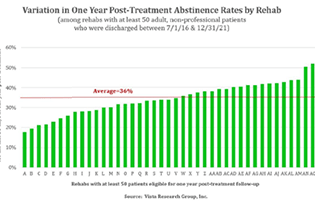To understand the areas in which your treatment center is excelling as well as opportunities for improvement, it is crucial to benchmark your performance against that of similar treatment centers. To make this easy to do, Vista regularly publishes the norms for centers in the Vista Research Network.
Between January 1, 2021 and June 30, 2023, Vista monitored the progress of 31,463 adults and 1,438 adolescents throughout their treatment at short-term SUD treatment centers. The vast majority of these centers promoted abstinence as the treatment goal.
Additionally, Vista has followed up post-treatment with over 25,000 patients who were in treatment between July 1, 2016 and June 30, 2023. This includes 15,603 adult SUD patients and 370 adolescent SUD patients who we attempted to contact at 12 months post-treatment.
Download Outcomes Norms
We will email you both the during-treatment norms and the post-treatment outcomes norms for adult SUD patients in a pdf format.
Download Treatment Norms for Adult SUD Patients
During-Treatment Patient Monitoring Norms
The analyses included in the during-treatment norms files are:
Demographics:
- Gender/Age
- Living Arrangements
- Marital Status/Ethnicity
- Employment
- Education
- Patient's Location
Why Patients Entered Treatment
Key Life Goals
Drug Use:
- Primary Drug of Choice
- Addiction Severity
- Previous Treatment Episodes
- Medication Supported Recovery
Co-Occurring Disorders at Intake:
- Overall Feeling
- Depression Symptoms (PHQ-9)
- Anxiety Symptoms (GAD-7)
- Trauma Symptoms (PCL-6)
- Eating Disorders(Dr. Eric Stice's EDDS)
- Other Disorders
- Suicidal Thoughts (CSSRS)
- Self-Harming Behavior
Co-Occurring Disorder Improvement During Treatment:
- Depression Symptoms (PHQ-9)
- Anxiety Symptoms (GAD-7)
- Trauma Symptoms (PCL-6)
- Eating Disorders (Dr. Eric Stice's EDDS)
- Suicidal Thoughts (CSSRS)
OMT & Anti-Craving Medication Use During Treatment:
- Happiness Taking Medication
- Medication Usage Differences Between Intake & Last Survey
Treatment Completion Rates:
- All programs
- By Source of Payment
- By OMT or Anti-Craving Medication
- By Program(s) Attended
Patient Satisfaction
Treatment Goals:
- Were patients asked about treatment goals
- Were treatment goals met
Addiction Treatment Outcomes Norms
The following analyses are included in the post-treatment outcomes norms charts:
Post-Treatment Abstinence:
- One Month Post-Treatment Abstinence
- Six Month Post-Treatment Abstinence
- Twelve Month Post-Treatment Abstinence
- Abstinent Rate Trends
- Speed of Relapse
Factors Favoring Abstinence Success:
- One Month Post-Treatment Abstinence by Treatment Completion
- Six Month Post-Treatment Abstinence by Treatment Completion
- Twelve Month Post-Treatment Abstinence by Treatment Completion
- Twelve Month Post-Treatment Abstinence by Drug of Choice
- Twelve Month Post-Treatment Abstinence by Length of Stay
- Twelve Month Post-Treatment Abstinence by After-Care Choices
Reduction in Severity of Co-Disorders:
- Depression Symptoms (PHQ-9)
- Anxiety Symptoms (GAD-7)
- Trauma Symptoms (PCL-6)
Quality of Life:
- Overall Feeling
- Stable Housing
- Relationship with Closest Family Member
- Employment
- Criminal Justice Offenses
- Progress on Achieving Non-Usage Related Goals at 12M Post-Treatment (Abstinence)
- Expensive Medical Interventions
Patient Satisfaction




